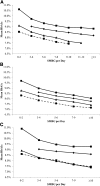Evidence of a strong association between frequency of self-monitoring of blood glucose and hemoglobin A1c levels in T1D exchange clinic registry participants
- PMID: 23378621
- PMCID: PMC3687326
- DOI: 10.2337/dc12-1770
Evidence of a strong association between frequency of self-monitoring of blood glucose and hemoglobin A1c levels in T1D exchange clinic registry participants
Abstract
Objective: Despite substantial evidence of the benefit of frequent self-monitoring of blood glucose (SMBG) in type 1 diabetes, certain insurers limit the number of test strips that they will provide. The large database of the T1D Exchange clinic registry provided an opportunity to evaluate the relationship between the number of SMBG measurements per day and HbA1c levels across a wide age range of children and adults.
Research design and methods: The analysis included 20,555 participants in the T1D Exchange clinic registry with type 1 diabetes ≥1 year and not using a continuous glucose monitor (11,641 younger than age 18 years and 8,914 18 years old or older). General linear models were used to assess the association between the number of SMBG measurements and HbA1c levels after adjusting for potential confounding variables.
Results: A higher number of SMBG measurements per day were associated with non-Hispanic white race, insurance coverage, higher household income, and use of an insulin pump for insulin delivery (P < 0.001 for each factor). After adjusting for these factors, a higher number of SMBG measurements per day was strongly associated with a lower HbA1c level (adjusted P < 0.001), with the association being present in all age-groups and in both insulin pump and injection users.
Conclusions: There is a strong association between higher SMBG frequency and lower HbA1c levels. It is important for insurers to consider that reducing restrictions on the number of test strips provided per month may lead to improved glycemic control for some patients with type 1 diabetes.
Figures

References
-
- Schiffrin A, Belmonte M. Multiple daily self-glucose monitoring: its essential role in long-term glucose control in insulin-dependent diabetic patients treated with pump and multiple subcutaneous injections. Diabetes Care 1982;5:479–484 - PubMed
-
- Schütt M, Kern W, Krause U, et al. DPV Initiative Is the frequency of self-monitoring of blood glucose related to long-term metabolic control? Multicenter analysis including 24,500 patients from 191 centers in Germany and Austria. Exp Clin Endocrinol Diabetes 2006;114:384–388 - PubMed
-
- Ziegler R, Heidtmann B, Hilgard D, Hofer S, Rosenbauer J, Holl R, DPV-Wiss-Initiative Frequency of SMBG correlates with HbA1c and acute complications in children and adolescents with type 1 diabetes. Pediatr Diabetes 2011;12:11–17 - PubMed
-
- Haller MJ, Stalvey MS, Silverstein JH. Predictors of control of diabetes: monitoring may be the key. J Pediatr 2004;144:660–661 - PubMed
-
- Levine BS, Anderson BJ, Butler DA, Antisdel JE, Brackett J, Laffel LM. Predictors of glycemic control and short-term adverse outcomes in youth with type 1 diabetes. J Pediatr 2001;139:197–203 - PubMed
Publication types
MeSH terms
Substances
Grants and funding
LinkOut - more resources
Full Text Sources
Other Literature Sources
Medical

